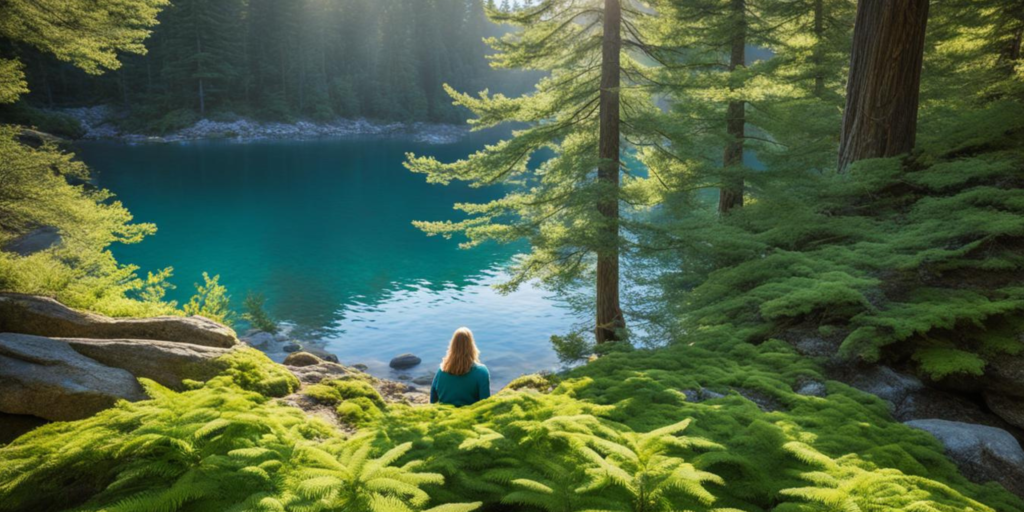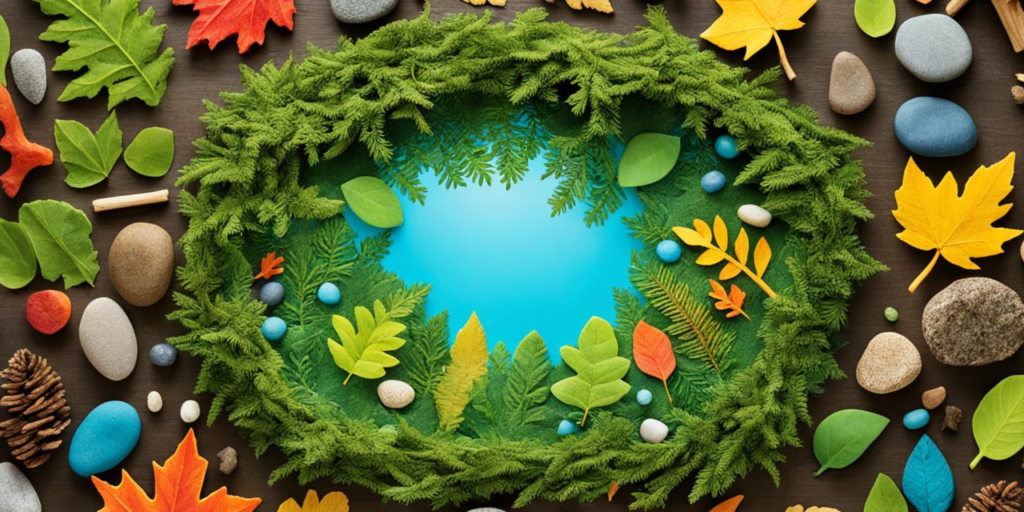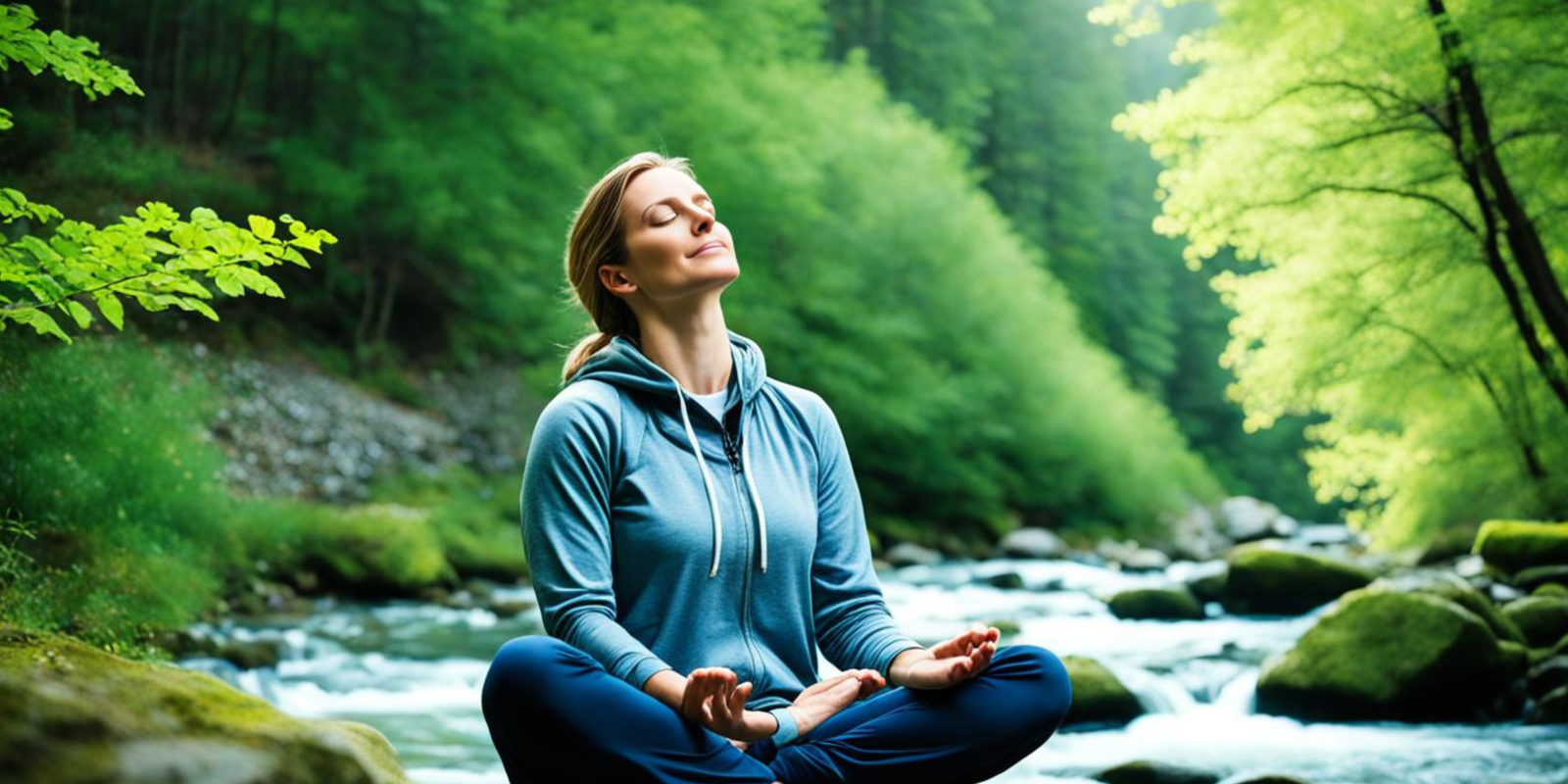“Nature Mindfulness” Many people give up on mindfulness. They do so because of challenges. But what if nature holds the key to making it work? Practicing mindfulness based on nature can bring you peace. They also create a strong link with the world around you.
A person sits cross-legged on a rock. They’re in the middle of a flowing river, surrounded by trees and mountains. The person has their eyes closed. Both hands are resting on their knees in a meditative position. The river is clear and reflects the image of the person and surrounding nature. The mountains in the background are misty. It’s possible to see birds flying in the sky.
Practicing mindfulness with nature is easier. It’s easier with others. It’s also better. Being in nature makes learning and growing easier. It helps create a group that cares for each other, like trees in a forest.

The Power of Nature Mindfulness
Being in nature is a great way to feel calm and at peace. It’s a simple, yet powerful way to feel good inside and out.
Doing mindfulness in nature helps us work well with others. It’s like a forest where all trees help each other. Being with nature and friends makes it easier to be mindful and better. “Nature Mindfulness”
Unlock the Benefits of Nature Mindfulness
Studies show that being outdoors calms our minds. It helps us to focus and relax better. It also boosts our immune system. It makes us more energetic and improves our sleep.
A study by the University of Illinois found that being mindful in nature can help with ADHD. Being mindful in nature also makes us more creative. It helps us solve problems better. It’s helpful in changing our mood from bad to good.
Walking in the park or meditating in a forest can change you. Joining a mindfulness group can too. It’s helpful in finding peace. It’s helpful in feeling renewed. It’s helpful in connecting with the world around you. “Nature Mindfulness”
Mindful Birding: Listen to Nature’s Symphony
Bird watching is usually all about looking for birds. But mindful birding is different. It enables rich senses. It fosters a deep bond with nature. We’ve listened to their calls. They’re like music.
For mindful birding, leave your camera and phone at home. Choose a place where birds are active. Silence yourself and let your ears take the lead. Notice the sounds around you. Listen to different bird calls. It’s enjoyable to enjoy the sounds of nature. Think about what the birds might be saying.
This quiet time can bring big thoughts. You might see birds flying higher to check their area. This shows that they talk about important things. Listening to their soft songs can calm us. It’s a feeling that makes us feel more connected with nature. Mindful birding teaches us to be close to nature. “Nature Mindfulness”
A solitary figure stands at the edge of a calm lake. It’s surrounded by green trees. It’s also near colorful flowers. They have binoculars in hand and are gazing up at a magnificent bird soaring in the sky. The sun casts a warm golden glow over the tranquil scene. Ripples dance across the water’s surface. They make a soothing symphony of nature sounds. “Nature Mindfulness”

Next time you visit your local park, forget about devices. Open your senses to mindful birding. It’s a peaceful way to enjoy nature’s beauty. “Nature Mindfulness”
Stone Balancing: Finding Equilibrium
Doing balance exercises helps lower stress. They also make you focus better. Stone balancing is a cool way to do this. It’s an old art where you stack stones in tricky ways.
First, you pick out stones. Then, you stack them high by yourself. After that, you try stacking with a friend without talking. This makes it harder.
Finally, you and your friend try a very hard stack. It’s like an upside-down triangle made of stones. Little stones go on the bottom, and big stones go at the top. It’s all about making sure each stone is in the right place so that it doesn’t fall over. “Nature Mindfulness”
Create an image that shows the art of stone balancing. In it, a person stacks stones on each other with care. They are different sizes. They do this to find balance. Place the stones in a natural setting. This could be by a river or on a beach. The background should have lush greenery. It should also have trees. The image should evoke peace and mindfulness. The person focuses their full attention. They immerse themselves in picturesque nature. Show the stones in vivid detail. Capture their unique textures and colors. A faint sunset or sunrise in the background could also add to the calm of the image. “Nature Mindfulness”

Stone balancing is more than putting rocks on top of each other. It’s calming and makes you think. It requires you to be patient and good at solving problems. Everyone becomes quiet and focused. They feel calm and happy. “Nature Mindfulness”
You can do stone balancing alone or with others. It’s a fun way to be mindful. This helps you focus and relax. You grasp nature’s intricate harmony.
Leaf Artistry: Mindful Immersion
Mindfulness is more fun. It’s fun when mixed with creativity and play. Leaf art activities can be a great way to slow down and enjoy the moment. They’ll make you feel more energized and take your mind to a place of pure imagination. “Nature Mindfulness”
Leaf Tracing: Tune In to Nature’s Details
Start by picking a leaf and tracing its outline. Examine the veins, curves, and edges in precise detail. This makes you focus, improves your senses, and helps you love nature more.
Leaf Collage: Collaborate for a Magical Forest Scene
Make a leaf collage with a friend. Find leaves of different shapes and colors to create a magical scene. This project makes you focus. It also brings you closer to your friend through art.
Leaf Mandala: Geometric Harmony in Nature
Get a group together to make a leaf mandala. Each person collects leaves by color or shape. Working as a team to arrange them can make you feel calm and amazed, all in the moment.
These art activities involve leaves. They help grow your creativity. They also help with mindfulness. They create a deep bond with nature. They savor every precious moment. Explore the natural beauty. Use it for your leaf tracing, collage, and mandala projects. “Nature Mindfulness”
Create an image of a single leaf. Surround it with nature. Use warm and earthy tones. Add the seven mindfulness practices for peace to the image. These include deep breathing. You must also be aware of your surroundings and let go of distractions. Use fine details and textures. They showcase the beauty and peace of nature in leaf art. “Nature Mindfulness”

Mindful Play: Expanding Your Mind with Nature
Being in nature makes us feel calm and alive. It helps us think and feel deeper. Nature has taught us many lessons. It did so through intentional outdoor play. It makes our brain strong and helps us understand our own feelings better. It’s also a fun way for kids to learn how to pay attention to the world around them.
Eating good food helps our bodies stay healthy. Like that, playing in nature helps our minds grow. What we see and feel in nature changes how we learn. Being outside helps us learn. It helps us learn about ourselves. We’ve embarked on a quest to discover our true identity. “Nature Mindfulness”
We can play in nature in many ways. Games like One Thing, Who Am I, It’s Imagination Game, I Spy, and Connections. They prove the interconnectedness of everything. They help us feel and think better. These activities let us make our world richer. They show us our deep link to all living things. “Nature Mindfulness”
- Inspect a natural object, like a leaf or rock, in detail. Feel it, see its colors, and its shape. Tell others what you’ve observed.
- Who Am I: Pretend to be something from nature. Share what life is like from its view.
- Imagination Game: Imagine you are a raindrop, a bird, or a tree. Feel and think like they would. Tell about your experience.
- I Spy: Play a game to find different things in nature. Look for things like leaves, birds, or it’s.
- Nature’s elements are all interconnected. Connections show this. Find out how plants, animals, and it’s working together.
Doing these mindful play activities is good for us. They help us feel and understand more. Plus, they make our minds good at dreaming and focusing. By enjoying nature, we’ve learned to love and take care of our world.
Create an image that shows mindfulness in nature. Focus on play and exploration. Show the viewer a scene. It is of a person or group of people interacting with nature. They do so in a way that fosters peace and harmony. Use plants, trees, water, and rocks. They create a calm and serene place. Add motion and movement. They convey playfulness and adventure.
They invite the viewer to join in the fun. Use the seven mindfulness practices. They include breathing exercises and mindful walking. Blend them seamlessly with the surroundings. They will enhance the sense of calm and inner peace. Let the colors and textures of the natural world shine through. They will create a beautiful experience for the viewer. “Nature Mindfulness”

Cultivating Awe and Wonder
Focusing on awe and wonder is a great mindfulness activity. It takes our minds off the bad thoughts. Instead, we’ve started to see the world in a better way. This makes a big change in how we perceive things. By looking at nature, we’ve found a deep sense of wonder. It can change us in a big way.
To see nature’s wonders, try a nature treasure hunt. You go out and find special items in nature. This helps you feel awe. Or, you could take photographs of the amazing things you see. Taking pictures can make you see things in a new light.”Nature Mindfulness”
Studies show that feeling awe is good for us. It’s making us feel more caring. It’s also making us feel connected to others.
- Kind and humble.
- Less stressed and healthier.
- Better at solving problems
- Feel more connected and it’s a purpose.
Awe comes from big and surprising things, like giant trees or the night sky. Focusing on these moments can make us more positive. And it’s when we start to love nature more.
Create an image of a nature treasure hunt. Use a variety of natural elements, such as leaves, rocks, and sticks. Show awe and wonder. Use vibrant colors and intricate textures. Depict a scene. The viewer feel like they’re exploring a hidden world. This world full of beauty and magic. Include small details. They tell the viewer to pause. They must then observe the details of nature. For example, the patterns on a leaf or the shape of a rock. Use light and shadow to add depth. They also highlight certain features. Make the scene calm and peaceful. Being in nature is a perfect escape from everyday hustle and bustle. “Nature Mindfulness”

Awe and wonder are all around us. We need to look. When we do, we find happiness in simple things. This changes how we feel. Nature brings peace and joy if it’s let. “Nature Mindfulness”
Nature Mindfulness
Practicing nature mindfulness is great. It helps you be calm and aware. You use seven important mindsets. These include a beginner’s mind and not judging. They help you enjoy mindfulness in nature.
Outdoor mindfulness starts with noticing your breath. It helps you focus in the now and relax. Your thoughts and feelings are key. They are key in nature mindfulness.
Studying nature in this way can make you happier and kinder. People find joy in small things like stars and rain. Connecting with nature makes us more open. “Nature Mindfulness”
Beneficial Nature Mindfulness Practices
- Practicing gratitude and appreciation is good. You can do it by taking a walk in nature. This can improve your mood.
- You can spark creativity by reflecting on nature. Do this by observing and exploring its shapes and spaces.
- You can notice changes in nature while walking in the same spot. You can connect with nature’s rhythms by sitting. You watch time pass. This can deepen the mindfulness experience. “Nature Mindfulness”
Specific Nature Mindfulness Activities
- You sit and watch natural processes. You watch until they’re done. You watch fog dissipate, the sun set, rain start or end, an animal leave, or a leaf fall.
- Observing natural phenomena connects us to nature. These include shadows and birdsong. It’s helped us form a deep bond with it. It also helps with understanding how the clouds move.
A survey of nature lovers showed that most feel amazed and peaceful. Another study found this. Seventy percent of them feel closer to the Earth. They understand this through deliberate examination.
A person stands barefoot on a grassy hill. They close their eyes and raise their arms towards the sky. A gentle breeze blows through their hair as they breathe in the fresh air. Birds soar overhead. Wildflowers bloom around them. The sun is setting over a nearby mountain range. It casts golden light across the scene. The person is serene. They merge with nature in perfect harmony. “Nature Mindfulness”

Nature observations spark inspiration in many individuals. It leads them to nurture it more. Nature walks bring calm to many individuals. It creates a strong emotional bond. It helps them feel connected to the Earth. After meditating in nature, 80% of people said they’d felt better. “Nature Mindfulness”
The Essence of Mindfulness
The essence of mindfulness is all about how we’ve seen and felt moments now. Jon Kabat-Zinn is a top name in mindfulness. He points out seven key attitudes. These are the core of a life-changing journey to mindfulness.
These mindfulness attitudes include:
- Non-judging – We don’t label our thoughts and feelings as good or bad.
- Patience – We’ve let things happen without rushing them along.
- Beginner’s Mind – We stay open and curious, like it’s all new.
- Trust – We believe in our own wisdom.
- Non-striving – We’ve let go of trying too hard and are in the moment.
- We welcome all experiences with kindness. This includes tough ones.
- Letting Go – We’ve dropped our tight hold on thoughts and ideas.
These mindfulness principles are the foundation. They are for living in the now. They bring peace and clarity within us. By using these ideas, we’ve found true mindfulness. This changes how we see the world.
A person sits cross-legged on a rocky outcrop. Their eyes are closed. They’re surrounded by trees and a flowing stream. The person’s posture should show inner peace and calm.
Embracing mindfulness in daily life has many rewards. It helps us see things without judgment. We’ve got to be open and patient. This leads to deeper insights about ourselves and our world. “Nature Mindfulness”

Conscious Breathing: The Foundation
Mindfulness starts with conscious breathing. It means watching your breath when you breathe in and out. It’s also called mindful breathing. Or, breath awareness. This practice helps you be in the now.
Inhale and exhale at a relaxed pace. With each breath, think “in,” then “out.” Keep doing this as long as you like. Your mind will calm, and your body will relax.
This kind of breathing practice can make you feel better. It helps your whole body. It can lower stress, help you focus, and bring inner peace. Focusing on your breath can quiet your mind and make you feel steady.
Remember, conscious breathing is key in mindfulness. It’s a simple but strong practice. You can do it anywhere, like when you sit to meditate, walk, or do your daily things. Doing this often shows you how powerful it is. “Nature Mindfulness”
Breathing like this is important. It’s important in Buddhism. It’s the first step in thinking about your body. Practitioners call this kayanupassana. You watch your breath in four parts. First, how breath goes in and out. Then, the whole breathing round, and your body moves with each breath.
Breath awareness can transform your life. So, take a second to stop and breathe right now. Breathe on purpose. It’s going to calm your mind and soothe your emotions. “Nature Mindfulness”
Seated Meditation: Find Your Center
Seated meditation is key in mindfulness meditation. You can sit many ways, like on the floor or in a chair. The point is to find a comfortable spot for your meditation practice.
Start by closing your eyes in seated meditation. Focus on your breathing. Watch the air come and go, but don’t try to change it. Feel your body’s feelings without judging them. This calm way of feeling is what makes mindfulness.
- Try using a mantra, such as “I have arrived” as you breathe in, and “it’s at home” as you breathe out. This keeps you in the present.
- Count your breaths, like “one” as you breathe in and “two” as you breathe out. This keeps your mind on track.
Start with one minute of seated meditation. Over time, make it longer as it gets easier. Be nice to yourself and stay calm. Soon, meditation will have helped you. You will feel centered. It’s also make you peaceful.
Seated meditation is not about being perfect. It’s about being right here, right now. Start the journey. Let meditation unfold on its own. “Nature Mindfulness”
You May Also Like:
Enhance Mindfulness Through Movement 5 Powerful Ways
Walking Meditation: Mindfulness in Motion
Walking meditation is a special way to move and think at the same time. It helps us stay connected to the present. You focus on each step, feeling how it connects you to everything around.
Examine each step carefully, noting every detail. Breathe in deeply as you take two steps. Breathe out slowly. Divide the breath into three parts. You can say things like, “It’s the green planet,” to match your step count. This makes your walking deep and focused, almost like a special way of thinking.
This type of meditation has many good effects. It can make you stand better, sleep better, and feel less worried. It helps with mood and keeps your mind sharp. In short, it brings peace and well-being to your life.
- Walk slower than usual, but not too slow. Take steps a bit smaller than normal.
- Try different ways to hold your hands. They could be behind you, in front, or by your sides.
- Do this kind of meditation for a few minutes up to twenty. Pay close attention to how your body moves.
Walking meditation makes us live in the moment. It also connects us with nature. Observe the surroundings. Absorb them, tuning in to natural sounds. It can make you feel joyful and peaceful.
So, trying walking meditation every day can change your life. It mixes moving with being aware. Enjoy every step and find peace in your life. “Nature Mindfulness”
Equanimity: The Key to Inner Peace
Finding inner peace means having a calm mind always, not when life is good. Mindfulness helps us stay balanced. It’s done so through life’s changes.
Learning to stay calm is possible. Even when life is hard, you can stay balanced. Mindfulness teaches us to be present and not let feelings take over.
Research shows that mindfulness practice calms us. Scientists have found that this helps the brain. It controls emotions well. This makes us react less and stay balanced more.
Mindfulness makes life’s tough moments easier. Instead of letting feelings drag us, we’ve got a choice how to respond. This keeps us peaceful inside, even in hard times.
True inner peace is about always being calm inside. If we’ve been mindful and calm, we can always find inner peace. “Nature Mindfulness“
You May Also Like:
Cultivating Inner Peace
Inner peace is something you make, not wish for. You can achieve it through meditation. You can also do so with breathing exercises. You can also do so with self-care and close relationships. These practices are key to finding the peace you want. It’s different for everyone, so try what feels right for you. “Nature Mindfulness”
To start finding peace inside, begin with these steps:
- Mindfulness Meditation can quiet your mind. It can also lower stress. Use guided meditations. Or, focus on your breath. This brings deep relaxation and awareness.
- Try deep breathing. Use the 4-7-8 technique. It will relax you. It’s a simple but effective way to find calm and balance.
- Practice Gratitude. Write in a gratitude journal daily. Listing three things you’re thankful for helps you focus on the good. It also helps you stay positive.
- Self-care and love can boost your confidence and mood. Being kind to yourself is the cause. Take care of yourself with enough sleep and a healthy diet.
- Physical Activity: Walking, yoga, and Tai Chi make you feel good. It’s boosts your mood and helps you face challenges better.
- Connect with Nature: Being in nature soothes your mind and body. Spend time outdoors. Enjoy it’s beauty for peace.
Finding inner peace is a process, not a quick fix. Stay calm, be in the moment, and believe in your journey. As you work on your peace, you’ll feel better and spread positivity. Keep at it, and you’ll see good changes in yourself and how you relate to others. “Nature Mindfulness”
Conclusion
Inner peace is a calm mind that comes from nature and focus. This article talks about ways to find peace in simple things outdoors. By using seven key ideas and the fresh air, you can find peace inside yourself.
Finding peace is a journey only you can take. It needs patience and focus. But with work and the right thoughts, peace can change your life. Jo CC Holistic PT in Geilston Bay has an online course to help for $49.
Joining the “Holistic Hiker” group online can give you more tips. Or you might like art with things from nature. Any way you do it, being in nature helps your mind be happy. It’s proven that being outside helps with stress and feeling good. So, go and find the peace waiting for you in nature. “Nature Mindfulness”









